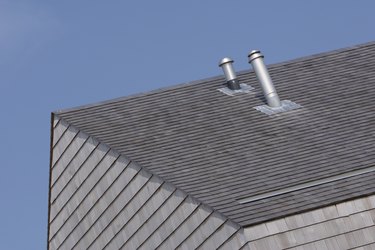
Heavy rain won't make a clogged toilet vent worse, but it can add to drain problems. Vent pipes or drain stacks provide an open airway to the side of the sewer system that drain traps isolate from the house. Water flowing down a drain pulls air along with it. With the sewer vent blocked, the draining water slows as it pulls air and water from other drain traps. Waterlogged septic system drain fields slow the drainage even more.
Drain Stacks
Video of the Day
Drain stacks, also called soil or sewer stacks, connect to the sewer side of the drain system. These open, straight pipes run up through an interior wall and through the roof. Sewer gas exits the system through the stack, and air needed for fast drainage rushes down the pipe every time a drain runs or a toilet flushes. A mixture of air and water moves through sewer pipes whenever drains run. If the stack clogs, the system pulls air through drain S-traps and can pull the water out of the toilet bowl. Empty traps let sewer gas into the house.
Video of the Day
Stack Clogs
Leaves can fall through the opening of the stack and jam against joints in the pipe. Inquisitive squirrels and birds in search of nesting sites sometimes enter vent stacks, become trapped, and die. In warm weather, debris clogs clear easily with sewer augers. In winter, snow and ice might build up inside pipes and gradually seal the opening. A bucket of hot water poured down the stack quickly removes ice and snow plugs, but working on an icy roof is very dangerous, and hot water won't solve the problem for long. Until the stack clears, drains run sluggishly and toilets might not completely flush.
Wet Weather
The house drains connect either to a municipal sewer main or to the home septic system. Except in areas prone to flooding, municipal sewers function normally even during heavy rain. Home septic systems depend on open drain fields to take the household waste water. If the drainage field becomes saturated by heavy rain, drains work unusually slowly and sewage can back up. If water levels in the septic system rise, sewer gas normally vented by the stack bubbles up through drain traps and toilets. Explosive methane might catch fire, and poisonous hydrogen sulfide and carbon monoxide might make occupants sick, according to the North Dakota State University Extension Service.
Solutions
Vent stacks 4 inches across should stay open in winter if the top rises at least 2 feet higher than any part of the roof within 10 feet, according to Purdue University Extension. If the stack passes through an unheated attic, the lower stack can still freeze shut. Wrapping the attic section with insulation keeps the pipe warmed by air rising from the sewer. Electric heating tape, used to protect water pipes from freezing, thaws vent stacks from the safety of the attic. If drain fields saturate frequently, ask a professional for advice. Expanding the drainage system or installing drainage tile above the drain field can help.
- Purdue University Cooperative Extension Service: Operating and Maintaining the Home Septic System
- South Dakota State University: Extension Specialist Offers Information for Dealing with Frozen Plumbing Vents
- North Dakota State University: Check Your Sewer Vents
- North Dakota State University: Septic Systems and Flooding